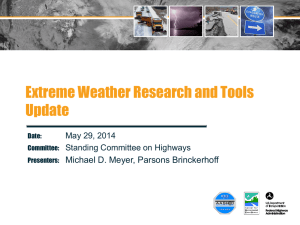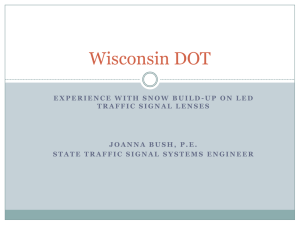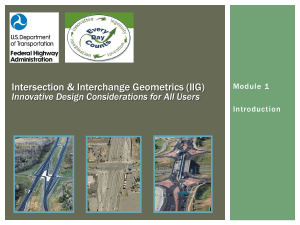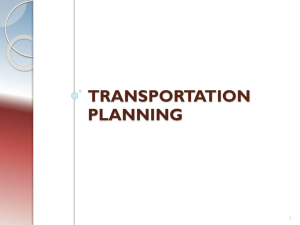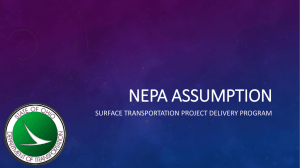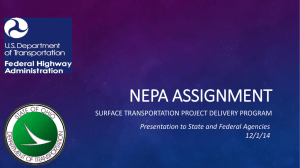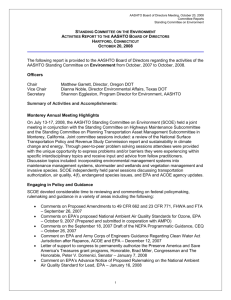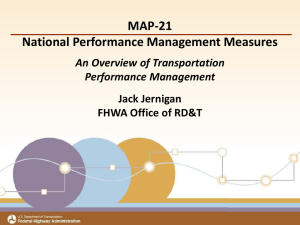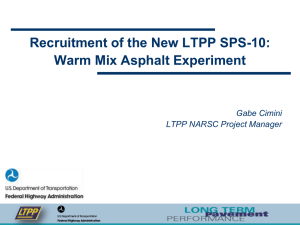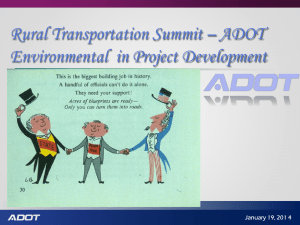Quality Environmental Documents
advertisement
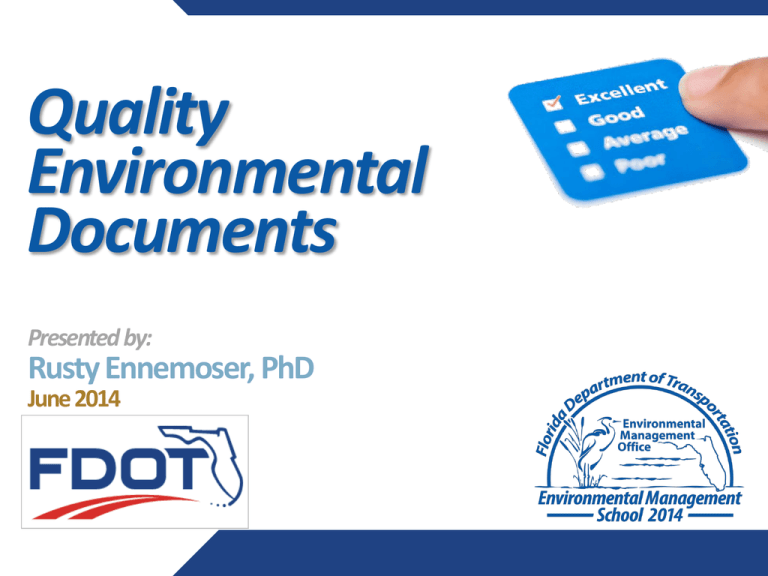
Quality Environmental Documents Presented by: Rusty Ennemoser, PhD June 2014 Why focus on quality? Consistent, predictable, repeatable Efficient quality reviews Clear expectations 2 Define Quality Do environmental documents satisfy regulations? Are they useful to the public and decision makers? Are they prepared in a way that reduces paperwork and delay? Keys to Efficient Development of Useful Environmental Documents (FTA, 2007) 3 Council on Environmental Quality Accurate scientific analysis, expert agency comments, and public scrutiny are essential to implementing NEPA. (40 C.F.R. § 1500.1(b)) 4 Council on Environmental Quality Focus on significant issues to be treated, not issues that are not significant or have been treated elsewhere, which should be eliminated from detailed study (40 C.F.R. § 1501.7(a)(2) and (3)) 5 Council on Environmental Quality Written in plain language, employing appropriate graphics so that decision makers and the public can readily understand them. (40 C.F.R. § 1502.8) 6 AASHTO/ACEC/FHWA 3 Core Principles Tell the story Be brief Meet legal requirements 7 AASHTO/FHWA Examples of Techniques Improving Overall Document Quality Meeting NEPA and Related Requirements 8 1. Tell the Story Readers easily understand… • Purpose and need for project • How each alternative would meet project goals • Strengths and weakness of each alternative 9 Techniques Provide a clear path of logic Tell the Story • What is the project trying to accomplish? • What are the effects? Write clearly for a broad audience Explain what the data mean in relation to the decisions to be made Use an editor to present a single voice 10 Project Example: Getting Organized Annotated Outline • Focus through scoping • Plan graphics Style guide • Grammar, word usage, acronyms, etc. Technical editor • Provide a single voice Document coordinator for production 11 Know Your Audience Public Tell the Story Decision Makers Regulators Resource Managers Judges 12 2. Be Brief Clear, concise writing Easy-to-follow format Effective graphics and visual elements Discussion in proportion to significance 13 Examples of Graphics 14 Which would you rather read? CalTrans’ Style Guide for Environmental Documents 15 Clear, Concise Writing Style Use • Everyday words • Active voice • Short sentences and paragraphs • Informative headings • Tables • Lists • Relevant illustrations Avoid Be Brief • Technical jargon • Acronyms • Noun strings • Modifiers • Doublets Federal Aviation Administration’s Plain Language Toolkit 16 Example Instead of this… Intersections that are projected to operate with especially long delays or overcapacity during the PM peak hour are identified as “congested intersections.” These intersections are those that operate under LOS F conditions (average vehicle delay of greater than 80 seconds) or ICU greater than 100 percent. Congested intersections are further identified as “highly congested” if they exceed 110 seconds of average vehicle delay and have an ICU greater than 110 percent. Washington State DOT’s Reader-friendly Document Toolkit 17 Example Say this… What are congested and highly congested intersections? Congested intersections are intersections that cause drivers considerable delay. A driver might wait between one and two minutes to get through a traffic signal at a congested intersection. At a highly congested intersection, a driver might wait two minutes or more to get through the traffic signal. Washington State DOT’s Reader-friendly Document Toolkit 18 Don’t dumb down; Clear up! Be Brief “Writing with greater clarity does not mean removing technical details from NEPA documents; it means explaining technical details in a way that is understandable to non-technical readers.” NCHRP Project 25-25(01) 19 Example Environmental regulatory agencies need a breakdown by type of wetland with the appropriate terminology. Explaining those technical terms is appropriate and helpful; eliminating them entirely is not. Palustrine Emergent Wetlands This type of wetlands is defined by the dominance of erect rooted herbaceous (not woody) wetland plants. If there is >30% cover of woody plants, then the type would be Scrub-Shrub or Forested. 20 Focus on Important Issues Use scoping process to limit detail Be Brief Include notes in annotated outline Concentrate on relevant issues and analyses Briefly discuss non-significant issues 21 Incorporate by Reference Separate technical information into Be Brief appendices Cross-reference rather than repeat details Summarize and refer to technical analyses and conclusions FHWA Every Day Counts: Implementing Quality Environmental Documentation 22 Example Examples of Effective Techniques for Improving the Quality of Environmental Documents (AASHTO/FHWA, 2014) 23 3. Meet Legal Requirements No longer than necessary to comply with NEPA and other legal / regulatory requirements Ensure the substance of the analysis is valid and understandable Evidence that the decision was not arbitrary and capricious Incorporate by reference 24 Make use of the project administrative record. 25 Legal Sufficiency Considerations Identify and explain key assumptions Describe methods used to develop data Use effective visuals to present key results Do not just summarize the data, explain what it means Document compliance with key regulatory requirements Provide an overview of major project issues Systematically review data to ensure internal consistency NCHRP 25-25(01) 26 Example Techniques to note: - Summarizes steps - Gives status of each step Examples of Effective Techniques for Improving the Quality of Environmental Documents (AASHTO/FHWA, 2014) 27 Every Day Counts Use clear, concise writing Prepare effective summaries, technical reports and other documentation Choose a flexible, easy-to-use document format Summarize information and use pictures and graphics Separate technical information into appendices or incorporate by reference Include only the most relevant information in the document Make the level of detail on a topic related to its relative importance and degree of harm to the project Incorporate by reference when possible and appropriate 28 http://environment.transportation.org/environmental_issues/nepa_process/recent_dev.aspx 29 Steps to a quality document Prepare an annotated outline Identify specific roles Use a technical editor – don’t rely on spell check Conduct stringent quality review by the district before submission Consult with SEMO throughout Provide to SEMO for review and approval 30 Next Steps Compile resources on web site Develop guidance Update manuals Provide training 31 For More Information Rusty Ennemoser, PhD 850-414-5337 rusty.ennemoser@dot.state.fl.us www.dot.state.fl.us/emo 32 Questions & Answers 33
